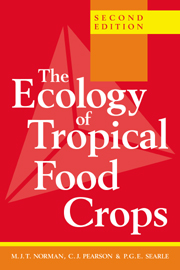14 - Non-cereal energy crops in tropical agriculture
Published online by Cambridge University Press: 05 June 2012
Summary
Introduction
The group of crops reviewed in this chapter, the four most important of which are considered in detail in Chapters 15–18, comprise species other than cereals that are grown in the tropics largely as human energy foods. Their somewhat clumsy designation as ‘non-cereal energy crops’ is the only properly inclusive and exclusive title that can be applied to such a diverse group. Thus cassava (Manihot esculenta, Euphorbiaceae) is a dicotyledonous short-lived perennial tuberous shrub grown as an annual or biennial; sweet potato (Ipomoea batatas, Convolvulaceae) is a dicotyledonous perennial tuberous herb grown as an annual; yams (Dioscorea spp., Dioscoreaceae) are monocotyledonous annual tuberous herbs; and bananas (Musa spp., Musaceae) are monocotyledonous perennial herbs with aerial fruit (Fig. 14.1).
Because in all instances the edible portion has a high water content and is therefore perishable, the crops are normally consumed locally in the fresh or home-processed state. There are two major exceptions: cassava, which although very important as a human food is also processed industrially for starch and liquid fuel and is exported in the dried form as stockfeed; and the sweet banana, the demand for which in high-income countries is such that it is exported fresh in large quantities.
There is a wide range of other less important non-cereal energy crops.
- Type
- Chapter
- Information
- The Ecology of Tropical Food Crops , pp. 257 - 266Publisher: Cambridge University PressPrint publication year: 1995



